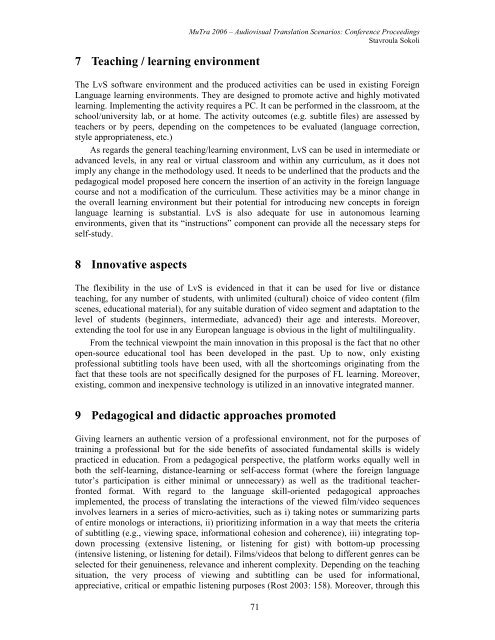Proceedings - Translation Concepts
Proceedings - Translation Concepts
Proceedings - Translation Concepts
You also want an ePaper? Increase the reach of your titles
YUMPU automatically turns print PDFs into web optimized ePapers that Google loves.
7 Teaching / learning environment<br />
MuTra 2006 – Audiovisual <strong>Translation</strong> Scenarios: Conference <strong>Proceedings</strong><br />
Stavroula Sokoli<br />
The LvS software environment and the produced activities can be used in existing Foreign<br />
Language learning environments. They are designed to promote active and highly motivated<br />
learning. Implementing the activity requires a PC. It can be performed in the classroom, at the<br />
school/university lab, or at home. The activity outcomes (e.g. subtitle files) are assessed by<br />
teachers or by peers, depending on the competences to be evaluated (language correction,<br />
style appropriateness, etc.)<br />
As regards the general teaching/learning environment, LvS can be used in intermediate or<br />
advanced levels, in any real or virtual classroom and within any curriculum, as it does not<br />
imply any change in the methodology used. It needs to be underlined that the products and the<br />
pedagogical model proposed here concern the insertion of an activity in the foreign language<br />
course and not a modification of the curriculum. These activities may be a minor change in<br />
the overall learning environment but their potential for introducing new concepts in foreign<br />
language learning is substantial. LvS is also adequate for use in autonomous learning<br />
environments, given that its “instructions” component can provide all the necessary steps for<br />
self-study.<br />
8 Innovative aspects<br />
The flexibility in the use of LvS is evidenced in that it can be used for live or distance<br />
teaching, for any number of students, with unlimited (cultural) choice of video content (film<br />
scenes, educational material), for any suitable duration of video segment and adaptation to the<br />
level of students (beginners, intermediate, advanced) their age and interests. Moreover,<br />
extending the tool for use in any European language is obvious in the light of multilinguality.<br />
From the technical viewpoint the main innovation in this proposal is the fact that no other<br />
open-source educational tool has been developed in the past. Up to now, only existing<br />
professional subtitling tools have been used, with all the shortcomings originating from the<br />
fact that these tools are not specifically designed for the purposes of FL learning. Moreover,<br />
existing, common and inexpensive technology is utilized in an innovative integrated manner.<br />
9 Pedagogical and didactic approaches promoted<br />
Giving learners an authentic version of a professional environment, not for the purposes of<br />
training a professional but for the side benefits of associated fundamental skills is widely<br />
practiced in education. From a pedagogical perspective, the platform works equally well in<br />
both the self-learning, distance-learning or self-access format (where the foreign language<br />
tutor’s participation is either minimal or unnecessary) as well as the traditional teacherfronted<br />
format. With regard to the language skill-oriented pedagogical approaches<br />
implemented, the process of translating the interactions of the viewed film/video sequences<br />
involves learners in a series of micro-activities, such as i) taking notes or summarizing parts<br />
of entire monologs or interactions, ii) prioritizing information in a way that meets the criteria<br />
of subtitling (e.g., viewing space, informational cohesion and coherence), iii) integrating topdown<br />
processing (extensive listening, or listening for gist) with bottom-up processing<br />
(intensive listening, or listening for detail). Films/videos that belong to different genres can be<br />
selected for their genuineness, relevance and inherent complexity. Depending on the teaching<br />
situation, the very process of viewing and subtitling can be used for informational,<br />
appreciative, critical or empathic listening purposes (Rost 2003: 158). Moreover, through this<br />
71
















